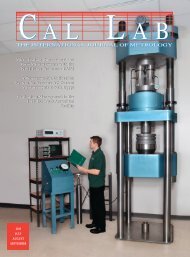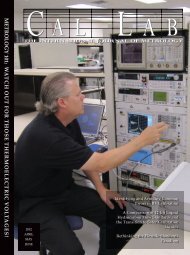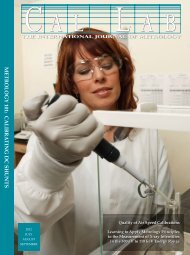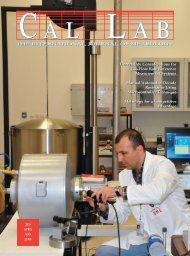METROLOGY 101: PISTON PROVER DESIGN - Cal Lab Magazine
METROLOGY 101: PISTON PROVER DESIGN - Cal Lab Magazine
METROLOGY 101: PISTON PROVER DESIGN - Cal Lab Magazine
You also want an ePaper? Increase the reach of your titles
YUMPU automatically turns print PDFs into web optimized ePapers that Google loves.
INDUSTRY AND RESEARCH NEWS<br />
All dimensional and material-property measurements<br />
that NIST used to characterize the reference devices<br />
conform with SEMI and ASTM International standard<br />
test methods. These standard methods are consensus best<br />
practices developed by industry committees.<br />
“Reference materials and best-practice test methods<br />
provide industry-wide benefits,” explains NIST<br />
electronics engineer Janet Cassard. “Typically, these<br />
tools are prohibitively expensive for a single company<br />
to develop on its own. We will work with the MEMS<br />
community to facilitate widespread adoption and<br />
consistent usage of these standard test methods and<br />
reference materials.”<br />
One test chip (RM 8096) is manufactured in an<br />
integrated circuit (IC) process; the other (RM 8097) in a<br />
MEMS process. The test chips are supported by a user’s<br />
guide, data analysis sheets for each measurement, and<br />
other materials accessible via the NIST Data Gateway with<br />
the keyword “MEMS <strong>Cal</strong>culator.”<br />
For more information, go to: http://www.nist.gov/srm/<br />
index.cfm.<br />
Source: NIST Tech Beat - April 30, 2013, http://www.nist.<br />
gov/public_affairs/tech-beat/index.cfm#mems.<br />
New NIST Time Code to Boost Reception for<br />
Radio-Controlled Clocks<br />
The National Institute of Standards and Technology<br />
(NIST) is changing the way it broadcasts time signals<br />
that synchronize radio-controlled “atomic” clocks and<br />
watches to official U.S. time in ways that will enable<br />
new radio-controlled timepieces to be significantly more<br />
robust and reliable.<br />
This new time broadcast protocol will not only<br />
improve the performance of new radio-controlled clocks<br />
and watches, but will encourage the development of<br />
new timekeeping products that were not practical with<br />
the old broadcast system because of local interference<br />
or other limitations. For example, appliances such as<br />
refrigerators, microwave ovens and thermostats, as well<br />
as traffic light timers and sprinkler systems will be able to<br />
take advantage of this new phase modulation broadcast.<br />
Popular radio-controlled timekeepers, which range<br />
from wristwatches to wall clocks, are not really atomic<br />
clocks—though that’s often in their name—but they do<br />
set themselves by listening to low-frequency AM time<br />
broadcasts from the NIST radio station WWVB in Fort<br />
Collins, Colo. Those broadcasts are synchronized to the<br />
NIST atomic clock ensemble in nearby Boulder, Colo.<br />
However, sometimes the radio-controlled clocks have<br />
difficulty accurately picking up the WWVB time signal<br />
because of the clock’s location, local radio interference,<br />
effects of buildings, and other problems. Moreover, a<br />
time broadcast from England on the same frequency also<br />
interferes with devices on the east coast of the United<br />
States that rely on the NIST broadcast, according to John<br />
Lowe, station manager for WWVB.<br />
To solve these problems, Lowe says, NIST has<br />
developed, tested and is now beginning to implement the<br />
new phase-modulation WWVB signal. Like a traditional<br />
AM radio station, time information is encoded in the<br />
WWVB broadcast by changes in the strength or amplitude<br />
of the radio signal. Phase modulation adds an additional<br />
layer of information encoded by shifting the phase of the<br />
carrier wave. (The crests of two waves that are “in phase”<br />
pass a point at the same time. If one is phase-shifted, the<br />
crest will arrive a little before or after the other.)<br />
This change significantly improves signal reception and<br />
overall performance of new products that are designed<br />
to utilize this new protocol. Legacy clocks and watches<br />
will still continue to function as they have because the<br />
amplitude modulation remains the same, but they will<br />
not benefit from the increased performance of the new<br />
phase modulation protocol, Lowe said.<br />
These new products and non-networked systems will<br />
be able to take advantage of the improved NIST broadcast<br />
format thanks to next generation receiver chips that will<br />
begin entering the marketplace in 2013.<br />
For more on radio-controlled clocks work with WWVB,<br />
see www.nist.gov/pml/div688/grp40/radioclocks.cfm.<br />
Source: NIST Tech Beat, March 5, 2013, http://www.nist.<br />
gov/public_affairs/tech-beat/tb20130305.cfm#wwvb.<br />
WorkPlace Training Metrology Academy<br />
WorkPlace Training, Emc3 Solutions and Quality<br />
Systems <strong>Lab</strong>oratory announce the opening of a World<br />
Class ISO 17025 accredited training facility in Boca Raton<br />
FL. Our new 11,600 sq ft facility contains the most state of<br />
the art measurement instruments and standards available.<br />
By attending our workshops you will receive hands on<br />
metrology training curriculum designed and delivered by<br />
WorkPlace Trainings Chief Technical Officer, Dilip Shah.<br />
Mr. Shah will lead the training and be assisted by Edward<br />
Brown and the staff at QSL. These 2 day workshops will<br />
be offered each year in the fall and winter. In addition,<br />
workshops can be scheduled throughout the year for your<br />
calibration staff by appointment.<br />
WPT Supports your training before the event with<br />
of elearning prerequisite; during the workshop with<br />
focused classroom and hands on demonstrations with<br />
check, working and reference standards; and after the<br />
workshop with telephone support. ASQ Recertification<br />
Units eligible.<br />
Check our website (www.wptraining.com) for more<br />
topics, learning objectives, audience, costs and dates.<br />
<strong>Cal</strong> <strong>Lab</strong>: The International Journal of Metrology<br />
12 Apr • May • Jun 2013










